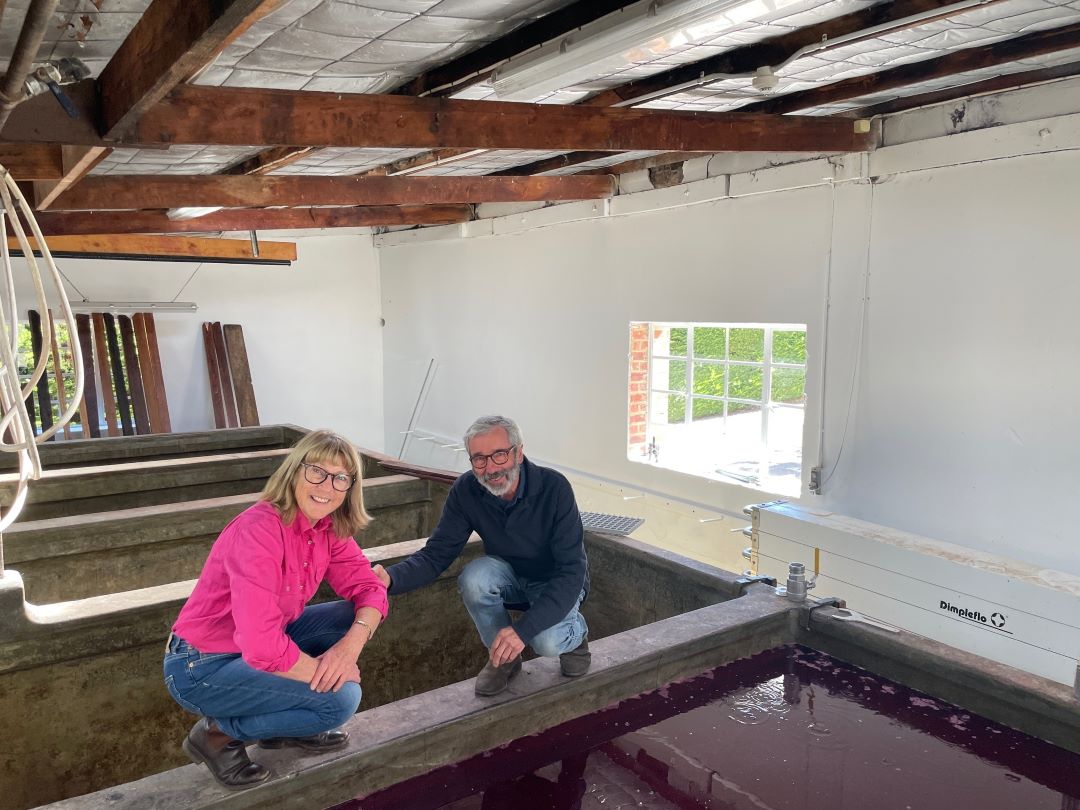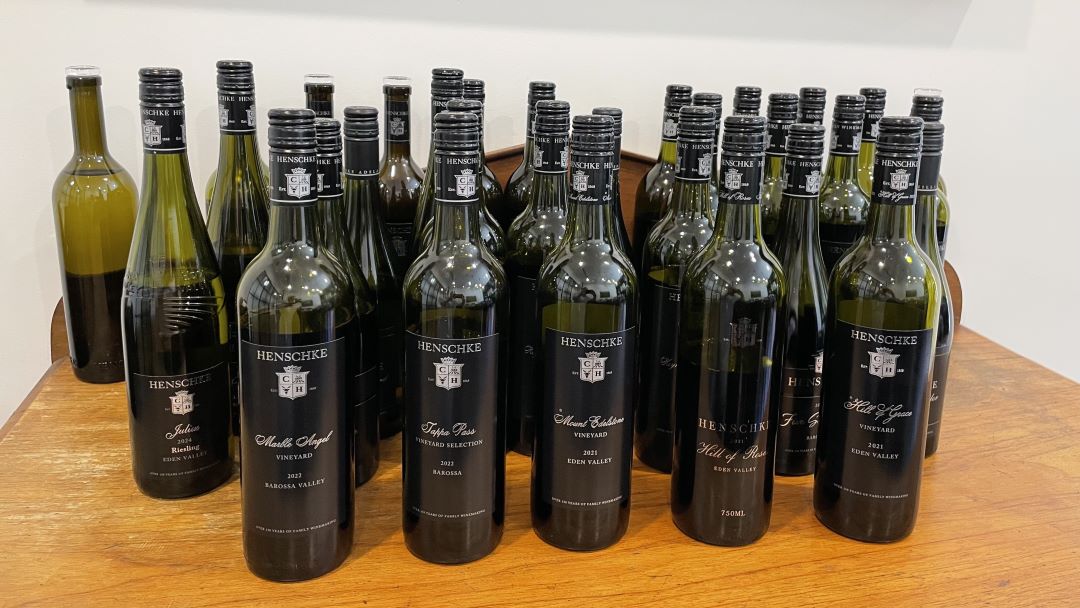Browse using the new Vinous website now. Launch →
Printed by, and for the sole use of . All rights reserved © 2015 Vinous Media
Cellar Favorite: A Landmark Vintage – Henschke 2021
BY ANGUS HUGHSON | APRIL 7, 202
Henschke is one of the most historic wineries in Australia, with a history stretching back to 1868, when the first wines were sold under the family name. Henschke’s rise to the head table of Australian wine is not a story of meteoric growth, but rather more of a long, hard and deliberate slog for over 150 years. Like many of the early Lutheran settlers to the Barossa Valley, the Henschkes were initially mixed farmers, with grapes being only one of the many strands of the family business. However, over time, the Henschkes focused on grapegrowing and wine production, gradually adding to their land holdings. This led to the 1891 purchase of a small vineyard near the Gnadenberg Church, which later became known as the Hill of Grace, and the eventual acquisition of the mature Mount Edelstone vineyard in 1974.
The Henschke home is located in the Eden Valley, high up above the Barossa Valley floor at an altitude of 400-500 meters. Estate vineyards fan out from the original winery, which remains in the spot where it was originally established in 1862. Importantly, Eden Valley is a subregion of the wider Barossa and differs markedly in both conditions and wine styles from its more famous neighbour. While the Barossa is home to robust and hearty wines, Eden Valley delivers a much more reserved expression of Shiraz. Eden Valley wines often have more in common with other parts of Australia than the classic Barossa style. In addition, the timing of key events during the growing season is quite different between the two regions, i.e., poor weather at flowering or hot spells in the Barossa may not be a problem later in the season in the Eden Valley, and vice versa.
There is always a traditional feel at Henschke—unforced wines that showcase their various terroirs. According to fifth-generation winemaker Stephen Henschke, “Henschke is about individual sites. We want to show the expression of our vineyards. There is not a lot of new oak for that reason. It’s about the vineyard flavours. It’s about the soils and the character of the region.” This transparent winemaking style, combined with a strong focus on sustainability, makes the annual Henschke release a true vintage snapshot of Eden Valley.
A key and highly necessary part of the pursuit of sustainability at Henschke has been the management of soil health, driven by Prue Henschke. The Eden Valley can be a harsh environment for vines due to unpredictable rainfall, particularly in hot, dry summers. The team focuses on building resilience in their vineyards to avoid the hard tannins and the baked characteristics that can emerge in the wines. There is a common misconception that old vines are less vigorous. But Stephen Henschke finds the opposite on their Mount Edelstone site, planted in 1912, where they utilise Scott-Henry training, albeit on a cooler east-facing site. “You would not believe the vigour in 100-year-old vines. The shoots cross over the rows. It just makes a difference, all those leaves working for us, producing flavour and colour. But there’s a catch: much more work in the vineyard and higher costs.”

Prue and Stephen Henschke with their open top fermenters.
Exploring Eden Valley
Henschke uses three quite different sites in the Eden Valley for top Shiraz and Cabernet Sauvignon. The historic, own-rooted Hill of Grace Vineyard was first planted in the 1860s, with additional parcels planted in 1910, 1951, 1952, 1956 and 1965. The vineyard sits at 400 meters of elevation in a fertile valley and on a very gentle slope with various aspects. On average, it is the driest of the Henschke estate vineyard, with sandy loam soils over clay. Of the lineup of Henschke Shiraz, Hill of Grace is typically the most powerful and tannic, which was certainly on display in the 2021 vintage.
Mount Edelstone Vineyard is quite different. Also situated at 400 meters, it was planted in 1912 on its own roots, using vinestock material that likely came from the first Shiraz clones brought to Australia from Hermitage in 1832. A gentle east-facing slope with clay soils over schist yields a more ethereal expression of Shiraz. While Hill of Grace is often more highly regarded, the difference in quality between these wines is negligible.
Planted by Cyril Henschke in 1968, the lesser-known Eden Valley Vineyard is deeper into the Mount Lofty ranges at a higher 500-meter elevation with greater rainfall. The Cyril Henschke Cabernet Sauvignon and Wheelwright Shiraz both come from this site. Historically, there were a number of vineyards in the area at the time of planting, but many have now been uprooted due to the challenging growing conditions and low yields, particularly in the cooler vintages that were prevalent before the 1980s. Undoubtedly, the northerly aspect of the Henschke Eden Valley Vineyard has been its saving grace.
Prue and Stephen Henschke added to the Eden Valley Vineyard in 1988, planting predominantly Cabernet Sauvignon, although Merlot and Cabernet Franc make up one-third of plantings and are used interchangeably for blending depending on vintage conditions. Occasionally, in less favourable vintages, Henschke does not bottle any wine off this site. For many years, Shiraz from this vineyard was a key component of the Keyneton Estate blend, but it has been bottled separately as The Wheelwright Shiraz since 2015. This year, I tasted mini-verticals of The Wheelwright (back to the inaugural vintage, 2015) and and the Cyril Henschke Cabernet Sauvignon (back to 2009). These wines offer a fascinating counterpoint against the Mount Edelstone and Hill of Grace, clearly showcasing the significance of vine age, but especially the character of the higher-altitude site. More than Hill of Grace and Mount Edelstone, the success of the Wheelwright Shiraz and Cyril Henschke Cabernet Sauvignon hinges on a kind season, due simply to the marginality of the site. In particular, Cyril Henschke Cabernet Sauvignon is a wine that can be truly outstanding when the weather plays dice, as occurred in the 2021 vintage. Its graceful, long-lived style and similarities with fine European Cabernet Sauvignon will surprise many.

The 2021 Growing Season
Two thousand twenty-one was set up well from the start, with a hot 2020 providing plenty of sunlight and supercharging buds for the following season. Flowering took place under placid conditions for most varieties, with only Mataro and Grenache affected by strong winds. Frost in September helped to control yields in some vineyards. However, in the lead-up to veraison, the vineyards were still carrying generous crop loads, with some significant heat in November and December providing a solid base of fruit development. The real key to the vintage was green harvesting, which Henschke undertook around the same time in all the vineyards. The process lent greater concentration to the resulting wines but also set the vines up for what was to come: the coolest Summer in 20 years. During this period, there were only five days over 30°C and none over 35°C, keeping the vines stress-free up until harvest, which took place for Hill of Grace on March 30 and 31. Without green harvesting, it is unlikely that the wines would have reached optimal ripeness in 2021. In summary, a placid but cool vintage combined with moderate yields helped to craft some of Henschke’s best in recent memory.
I tasted the wines for this report at the winery in February 2025. While the focus was on the new single-vineyard releases, the tasting also included an array of wines from Eden Valley, Barossa and Adelaide Hills.
© 2025, Vinous. No portion of this article may be copied, shared or redistributed without prior consent from Vinous. Doing so is not only a violation of our copyright but also threatens the survival of independent wine criticism.
